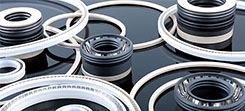How to ensure the sealing performance of lip seal seals for Cryogenic valves?
1.Material Selection
1. Low temperature resistance: It is key to choose materials with excellent low temperature resistance. For example, perfluoroether rubber (FFKM), with its glass transition temperature as low as -20℃ or below, can still maintain good elasticity and flexibility in ultra-low temperature environment, which can effectively avoid seal failure due to hardening and brittleness of the material.
2. Chemical resistance: to consider the medium that the seal may come into contact with, to ensure that the material has good chemical resistance to these media. For example, in the liquefied natural gas (LNG) environment, the selected material should be able to withstand methane and a small number of impurities (such as hydrogen sulfide, etc.) corrosion, to prevent the material from being eroded by chemicals and damage to the sealing performance.
3. Low permeability: for gaseous media, the low permeability of the material is very important. For example, in the liquid hydrogen valves, should be selected with low permeability materials to prevent hydrogen leakage. Reduce the permeability of the material by selecting specially formulated rubber materials or adding nano-scale barrier materials.
2. Correct installation
1. Check before installation:
1. Make sure the sealing surface is flat, smooth and free from damage. Any tiny scratches or bumps may affect the fit of the seal to the sealing surface and lead to leakage. For example, use a high-precision gauge to check the sealing surface, and its surface roughness should meet the requirements.
2. Check the seal itself for defects, such as breakage, cracks, deformation and so on. At the same time, make sure the seal is clean to avoid impurities mixing in.
2. Installation process:
1. Install the sealing ring in the correct direction, generally the lip should be towards the medium side. In the installation process, use the appropriate tools to avoid excessive force leading to seal ring distortion or lip damage. For example, for small lip seals, a special plastic installation tool can be used to install the seal slowly and smoothly into the sealing groove.
2. For lip seals with springs, make sure that the springs are installed correctly and are in a good state of compression. The role of the spring is to assist the seal to maintain a close fit when the medium pressure changes, improper installation will affect the sealing effect.
3. Reasonable use and maintenance
1. Control of operating conditions:
1. Control the valve's operating pressure and temperature within the allowable range of the seal. If the pressure is too high, the seal may be excessively deformed and lose its sealing function; the temperature is too low beyond the material tolerance range, which will lead to a decline in seal performance. For example, in the valve operating instructions clearly specify the operating parameters, and install pressure and temperature monitoring devices.
2. Try to reduce the valve's frequent opening and closing operations, because each opening and closing will make the seal by friction and deformation of the impact. In some occasions where the sealing requirements are very high, such as in liquid hydrogen storage systems, the valve operation process should be planned rationally to reduce the risk of seal wear.
2. Regular inspection and replacement:
1. Regularly check the condition of the seals, including the wear of the lips and signs of material deterioration (e.g. discolouration, hardening, etc.). The performance of the seal can be judged by visual inspection, tactile inspection and some simple tool tests (e.g. durometer to detect changes in material hardness).
2. According to the inspection results and the service life of the seal, replace the seal in time. Generally speaking, the service life of seals is affected by the use of environment, frequency of operation and other factors, to establish a reasonable replacement cycle to ensure that the sealing performance is always reliable.
4. Optimise the sealing structure design
1. Matching accuracy: when designing the matching structure of the valve and sealing ring, make sure that the size of the sealing groove matches the size of the sealing ring accurately. Too large a sealing groove will make the seal ring wobble in it, affecting the seal; too small a sealing groove will lead to installation difficulties, or even damage the seal ring. For example, the optimum dimensional tolerances of the sealing groove and sealing ring are determined at the design stage through precise calculations and simulations.
2. Multiple sealing design: In some of the extremely high sealing requirements of ultra-low temperature valves, multiple sealing structures can be used, such as double-lip sealing ring or lip sealing ring based on the addition of auxiliary sealing structure. Double lip sealing ring of a lip to prevent leakage of media, another lip to prevent the entry of external impurities, thereby improving the overall sealing performance.


 Resources&Tools
Resources&Tools
 Resources&Tools
Resources&Tools






